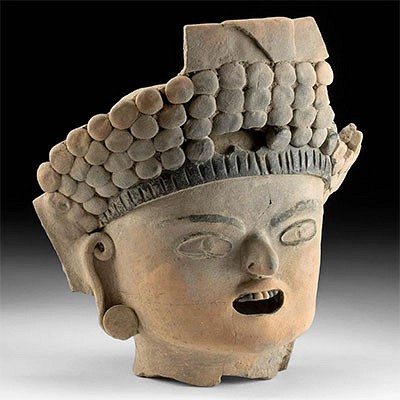Pair of Scythian Repousse Gold Plaques, Lion & Deer
Lot 98a
About Seller
Artemis Fine Arts
686 S Taylor Ave, Ste 106
Louisville, CO 80027
United States
Selling antiquities, ancient and ethnographic art online since 1993, Artemis Gallery specializes in Classical Antiquities (Egyptian, Greek, Roman, Near Eastern), Asian, Pre-Columbian, African / Tribal / Oceanographic art. Our extensive inventory includes pottery, stone, metal, wood, glass and textil...Read more
Categories
Estimate:
$2,000 - $3,000
Absentee vs Live bid
Two ways to bid:
- Leave a max absentee bid and the platform will bid on your behalf up to your maximum bid during the live auction.
- Bid live during the auction and your bids will be submitted real-time to the auctioneer.
Bid Increments
| Price | Bid Increment |
|---|---|
| $0 | $25 |
| $300 | $50 |
| $1,000 | $100 |
| $2,000 | $250 |
| $5,000 | $500 |
| $10,000 | $1,000 |
| $20,000 | $2,500 |
| $50,000 | $5,000 |
| $100,000 | $10,000 |
| $200,000 | $20,000 |
About Auction
By Artemis Fine Arts
May 18, 2023
Set Reminder
2023-05-18 10:00:00
2023-05-18 10:00:00
America/New_York
Bidsquare
Bidsquare : Ancient | Asian | Ethnographic Art
https://www.bidsquare.com/auctions/artemis-gallery/ancient-asian-ethnographic-art-12797
Featuring classical antiquities, ancient, and ethnographic art from cultures encompassing the globe. Egyptian, Greek, Roman, Near Eastern, Asian, Pre-Columbian, Native American, African / Tribal, Oceanic, Spanish Colonial, Fossils, more! All legally acquired, legal to sell. Satisfaction guaranteed. Artemis Fine Arts info@artemisfinearts.com
Featuring classical antiquities, ancient, and ethnographic art from cultures encompassing the globe. Egyptian, Greek, Roman, Near Eastern, Asian, Pre-Columbian, Native American, African / Tribal, Oceanic, Spanish Colonial, Fossils, more! All legally acquired, legal to sell. Satisfaction guaranteed. Artemis Fine Arts info@artemisfinearts.com
- Lot Description
Western Asia, Scythian culture, ca. mid-1st millennium BCE. An enticing pair of gold applique plaques, each displaying lively repousse images of a lion attacking a deer. The ferocious feline curves its body in an almost circular fashion as it completes its pounce, clawing the ungulate's hindquarters with its back legs and biting just below the deer's neck. In response, the recumbent prey raises its head dramatically, crying out in agony. All is surrounded by a decorative, striped border, as well as 4 petite perforations for attachment. Depictions of predatory felines and ungulate quarry are central to the art of the Scythians whose world was nomadic and pastoral, intimately connected to the lives of animals, and vulnerable to predators and the elements. Size (both about the same): 1.4" W x 1.2" H (3.6 cm x 3 cm); metal quality: 78% gold (equivalent to over 18 karats), 15% silver, & 5% copper; total weight: 2.6 grams
The Scythians are famous for their goldwork, and rightly so; hoards of their treasures have been found throughout eastern and central Europe and western and central Asia. Scholars have posited that these hoards may represent gifts for foreign rulers, votive offerings, or treasures buried and forgotten. Other gold artifacts from this culture are found in their incredibly rich graves. According to Scythian tradition, warriors (both male and female) were buried alongside their servants and horses, with weapons, harnesses, and personal adornments in order to provide for them in the afterlife.
Provenance: East Coast collection, New York Gallery, New York City, New York, USA, acquired before 2010
All items legal to buy/sell under U.S. Statute covering cultural patrimony Code 2600, CHAPTER 14, and are guaranteed to be as described or your money back.
A Certificate of Authenticity will accompany all winning bids.
We ship worldwide and handle all shipping in-house for your convenience.
#177843One has a minor hairline tear to top periphery and another small tear with folding to lower right corner. Both have slight bending to form but are otherwise intact and excellent with impressive preservation of repousse imagery and detail.Condition
- Shipping Info
-
All shipping is handled in-house for your convenience. Your invoice from Artemis Gallery will include shipping calculation instructions. If in doubt, please inquire BEFORE bidding for estimated shipping costs for individual items.
-
- Buyer's Premium



 EUR
EUR CAD
CAD AUD
AUD GBP
GBP MXN
MXN HKD
HKD CNY
CNY MYR
MYR SEK
SEK SGD
SGD CHF
CHF THB
THB













